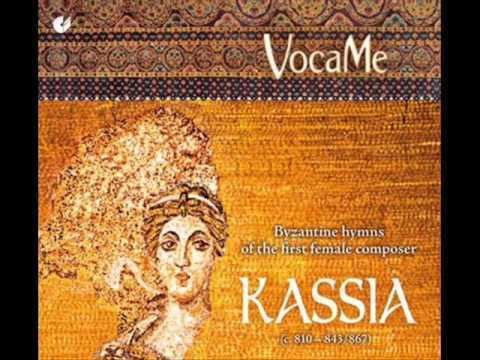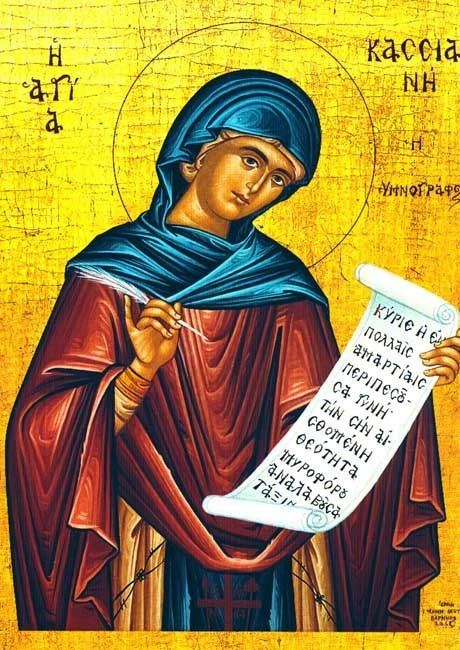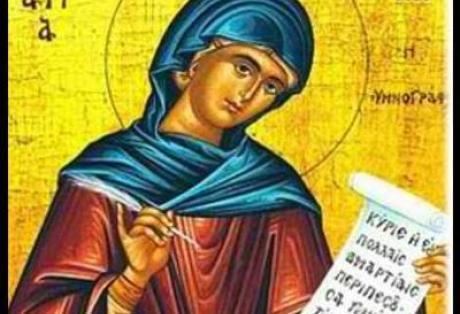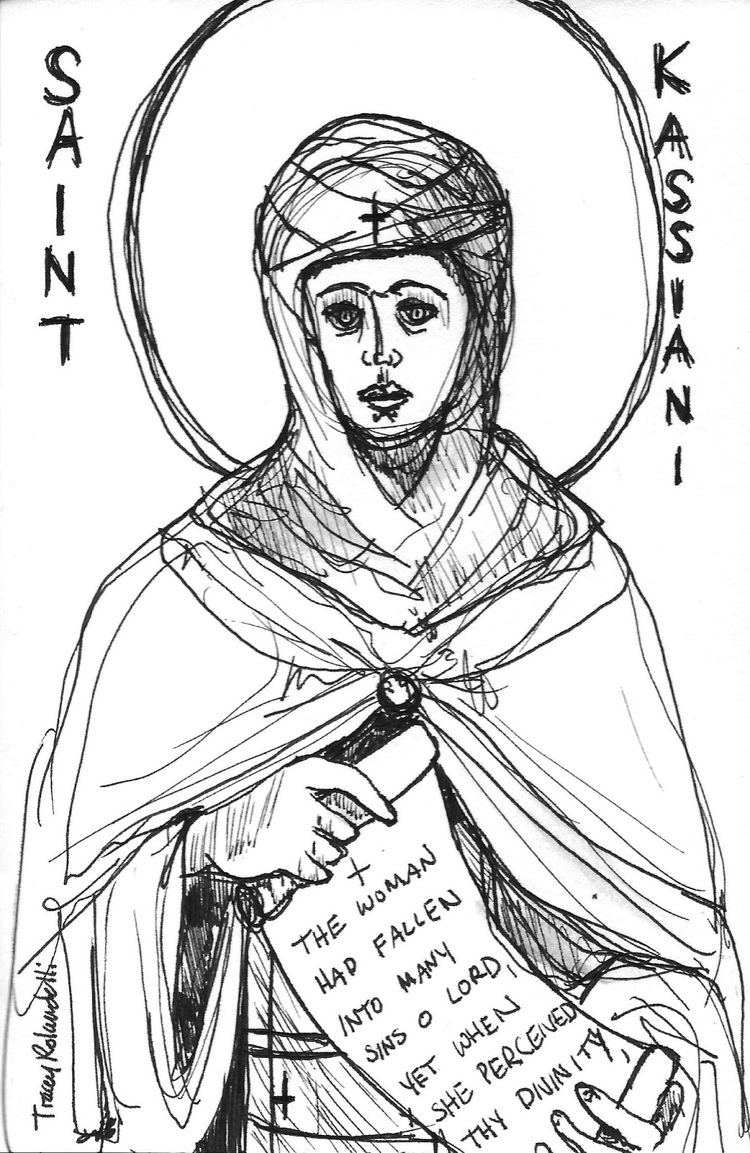Name Kassiani Kassiani | ||
The hymn of saint kassiani
Kassiani (Greek: Κασσιανή [kasia'ni]; 805/810 - before 865) was a Byzantine abbess, poet, composer, and hymnographer. She is one of the first medieval composers whose scores are both extant and able to be interpreted by modern scholars and musicians. Approximately fifty of her hymns are extant and twenty-three are included in Orthodox Church liturgical books. The exact number is difficult to assess, as many hymns are ascribed to different authors in different manuscripts and are often identified as anonymous.
Contents
- The hymn of saint kassiani
- 008 kassiani avi
- Name
- Life
- Works
- Hymn of Kassiani
- Other works
- Religious commemoration
- Recordings
- References

In addition, some 789 of her non-liturgical verses survive. Many are epigrams or aphorisms called "gnomic verse", for example, "I hate the rich man moaning as if he were poor."

Kassiani is notable as one of only two Byzantine women known to have written in their own names during the Middle Ages, the other being Anna Comnena.

008 kassiani avi
Name

Her name is a feminine Greek form of the Latin name Cassius. It is variously spelled Κασσιανή (contemporary pronunciation [casˈsjani]), Κασ(σ)ία (Kas[s]ia), Εικασία (Eikasia), Ικασία (Ikasia), Kassiani, Cas[s]ia, Cassiane, 'Kassiana.
Life

Kassiani was born between 805 and 810 in Constantinople into a wealthy family and grew to be exceptionally beautiful and intelligent. Three Byzantine chroniclers, Pseudo-Symeon the Logothete, George the Monk (a.k.a. George the Sinner) and Leo the Grammarian, claim that she was a participant in the "bride show" (the means by which Byzantine princes/emperors sometimes chose a bride, by giving a golden apple to his choice) organized for the young bachelor Theophilos by his stepmother, the Empress Dowager Euphrosyne. Smitten by Kassiani's beauty, the young emperor approached her and said: "Through a woman [came forth] the baser [things]", referring to the sin and suffering coming as a result of Eve's transgression. Kassiani promptly responded by saying: "And through a woman [came forth] the better [things]", referring to the hope of salvation resulting from the Incarnation of Christ through the Virgin Mary. According to tradition, the verbatim dialogue was:

"-Ἐκ γυναικὸς τὰ χείρω." Medieval Greek: [ek ʝyne'kos ta 'çiro]
"-Kαὶ ἐκ γυναικὸς τὰ κρείττω." Medieval Greek: [c(e) ek ʝyneˈkos ta ˈkrito]

His pride wounded by Kassiani's terse rebuttal, Theophilos rejected her and chose Theodora as his wife.
When next we hear of Kassiani in 843 she had founded a convent in the west of Constantinople, near the Constantinian Walls, and became its first abbess. Although many scholars attribute this to bitterness at having failed to marry Theophilos and become Empress, a letter from Theodore the Studite indicates that she had other motivations for wanting a monastic life. It had a close relationship with the nearby monastery of Stoudios, which was to play a central role in re-editing the Byzantine liturgical books in the 9th and 10th centuries, thus ensuring the survival of her work (Kurt Sherry, p. 56). However, since the monastic life was a common vocation in her day, religious zeal is as likely a motive as either depression or aspiration for artistic renown.
The Emperor Theophilos was a fierce iconoclast, and any residual feelings he may have had for Kassiani did not preserve her from the imperial policy of persecution for her defence of the veneration of icons. Among other things, she was subjected to scourging with a lash. In spite of this, she remained outspoken in defence of the Orthodox Faith, at one point saying, "I hate silence, when it is time to speak."
After the death of Theophilos in 842 his young son Michael III became Emperor, with the Empress Theodora acting as Regent. Together they ended the second iconoclastic period (814-842); peace was restored to the empire.
Kassiani traveled to Italy briefly, but eventually settled on the Greek Island of Kasos where she died sometime between 867 and 890 AD. In the city of Panaghia, there is a church where Kassiani's tomb/reliquiary may be found
Works
Kassiani wrote many hymns which are still used in the Byzantine liturgy to this day. Kassiani became known to the great Theodore the Studite, while she was still a young girl, and he was impressed by her learning and literary style. She not only wrote spiritual poetry, but composed music to accompany it. She is regarded as an "exceptional and rare phenomenon" among composers of her day At least twenty-three genuine hymns are ascribed to her.
Hymn of Kassiani
The most famous of her compositions is the eponymous Hymn of Kassiani (also known as the Troparion of Kassiani), sung every Holy Wednesday (commonly chanted late in the evening of Holy Tuesday).
Tradition says that in his later years the Emperor Theophilus, still in love with her, wished to see her one more time before he died, so he rode to the monastery where she resided. Kassiani was alone in her cell, writing her Hymn when she realized that the commotion she heard was because the imperial retinue had arrived. She was still in love with him but was now devoted to God and hid away because she did not want to let her old passion overcome her monastic vow. She left the unfinished hymn on the table. Theophilus found her cell and entered it alone. He looked for her but she was not there; she was hiding in a closet, watching him. Theophilus, overcome with sadness, cried and regretted that moment of pride when he rejected such a beautiful and intellectual woman; then he noticed the papers on the table and read them. When he had finished reading, he sat and added one line to the hymn; then he left. The line attributed to the Emperor is the line "those feet whose sound Eve heard at dusk in Paradise and hid herself for fear". Legend says that as he was leaving he noticed Kassiani in the closet but did not speak to her, out of respect for her wished privacy. Kassiani emerged when the emperor was gone, read what he had written and finished the hymn.
The Hymn of Kassiani is chanted only once a year during Holy Week, at the end of the aposticha at Matins on Great and Holy Wednesday, which is traditionally served in Tuesday evening. The music for the hymn is slow, sorrowful and plaintive. It lasts about ten to twenty minutes, depending on tempo and style of execution. It requires a very wide vocal range, and is considered one of the most demanding, if not the most demanding, pieces of solo Byzantine chant, and cantors take great pride in delivering it well. It is also sung by choirs in unison, often underpinned by Byzantine vocal bass drone. The faithful make a point of going to church specifically "to listen to Kassiani" that evening:In many places in Greece, the Bridegroom Matins service of Great Tuesday is popular with sex workers, who may not often be seen in church at other times of the year. They come in great numbers, in order to hear the Hymn of Kassiani, as the hymn is traditionally associated with the woman fallen in many sins.
Other works
Among the other hymns she composed are the following:
Religious commemoration
The feast day of Saint Kassiani is celebrated by the Orthodox Church on September 7.
She is often depicted on the icon of the Sunday of Orthodoxy (the First Sunday of Great Lent), because of her strong defence of the veneration of icons.
Recordings
The following are commercial recordings of the music of Kassiani:
